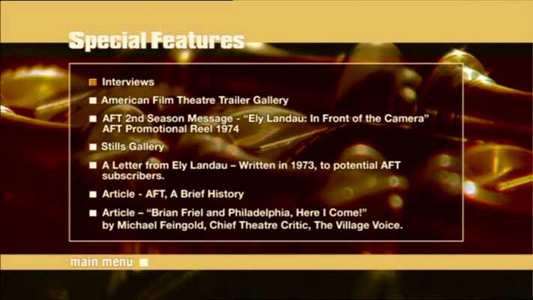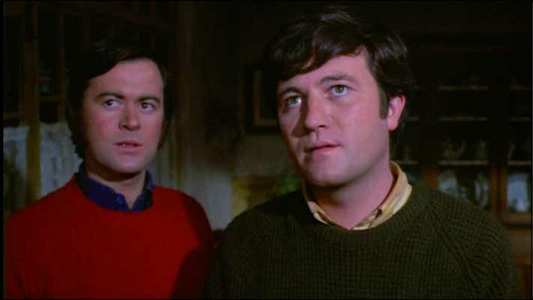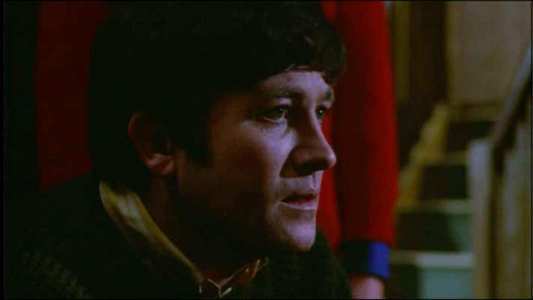Review of Philadelphia, Here I Come
Introduction
The American Film Theatre is not about making movies; it makes films of plays, both classic and contemporary. Often casting the best actors, it`s a matter of recording the play for posterity. While years may pass between performances in the theatre, you know that there is always the option of seeing the play this way, and more often than not, with the blessing of the playwright. Also available are plays like The Maids with Glenda Jackson and Susannah York, The Iceman Cometh with Lee Marvin, Robert Ryan and Jeff Bridges, and Laurence Olivier`s production of Three Sisters.
Philadelphia, Here I Come was written by Brian Friel, and tells the story of a young man about to leave his native town in Ireland for the cosmopolitan world of the United States. Gar O`Donnell`s last day in Ireland is cause for reflection, and we learn of the reasons that he is leaving, and his conflicted feelings.

Video
The picture is presented anamorphically in a 1.85:1 ratio. The film was made in 1971, and it`s hardly your Hollywood blockbuster. Unsurprisingly the image is a little dull and not that well defined. I suppose it`s the quality of the original film, but the resolution was barely sharper than that of videotape. Also there were occasional moments of print damage.

Audio
The sound is similarly unspectacular. A DD 2.0 mono track, it`s dull to say the least, and is accompanied by hiss and the occasional crackle. The dialogue is clear enough, though there are no subtitles on this disc. I also noticed that the sound was ever so slightly out of sync for the last ten minutes or so.

Features
The extras on this disc complement both the play and the American Film Theatre quite well.
There are two interviews on this disc, the first is with Director of Philadelphia, Here I Come, John Quested, and he talks for 21 minutes about the play, the filming process and the actors. Secondly there is Edie Landau, executive in charge of the American Film Theatre, who for 23 minutes gives a mission statement for the AFT, and what they have accomplished. Both of these are presented anamorphically.
The AFT trailer gallery houses trailers for 10 other plays, committed to celluloid by the AFT.
The AFT 2nd Season message is a promo reel lasting for 6 minutes. Filmed in 1974, Ely Landau thanks viewers for watching the first season of plays and invites viewers to the second season.
There are three pictures from the film in a stills gallery, a letter from Ely Landau to subscribers, a text article relating a brief history of the AFT, and another article on Brian Friel and Philadelphia, Here I Come by Michael Feingold.

Conclusion
While I can see the wisdom in recording plays for posterity, they tend to lose a lot in translation from stage to screen. That`s why plays are usually adapted rather than performed as is. Philadelphia, Here I Come is a perfect example of this, despite being shot on location in Ireland for verisimilitude. The immediacy of a live theatrical performance is lost when transferred to a small or large screen, and there is a glass wall that comes up between audience and performers. The vibrancy is lost, and the simple reason is that the stage and the screen are two different mediums. Where a theatrical performance hinges on an actor`s performance, the cinema relies more on a director`s vision, it literally is painting with light. Through sound and image, a director elicits emotions. Simply transferring a play onto screen without making use of these tools is what makes watching it an academic experience, and watching Philadelphia, Here I Come was a supremely academic experience for me.
While moving the story on location to a small Irish village certainly helps in setting up the feel of the tale, not enough use is made of the location to take it outside the theatre. Gar`s motives for leaving home are explored, and some are certainly familiar to this second generation immigrant, the search for greener pastures, and the promise of affluence across the ocean, and the dreary routine ennui of small town life. However Gar`s motives are also personal, with a failed relationship, and his inability to communicate with his father urging him to leave. An inability to communicate, while prevalent among many a father and son, would make for a short movie, but this is solved by introducing Private Gar as opposed to Public Gar. Private Gar is Gar`s conscience, his thoughts, and his confidante. A verbose figure in a red jumper, he appears to give us Gar`s inner thoughts, and says what he would rather say instead of merely remaining silent. Again in a movie this would be simply accomplished by means of a voiceover, though it would be difficult for a character to have a conversation with his voiceover.
In the end, this play really didn`t add a lot to the immigrant`s story, and fathers and sons have been failing to communicate for generations. There is a glimpse of how life was in Ireland thirty years ago, but isn`t enough to bridge that gap between the audience and the other side of the television screen. One for fans of the play only.
Your Opinions and Comments
Be the first to post a comment!